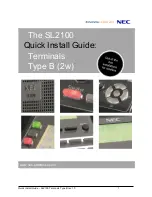
279
Areas for Control/Notification
Section 7-2
Reference: Whether the backlight is lit continuously or flashes when the “backlight status” bit is
set to “1” (ON) is determined by the “backlight mode” bit (bit 8) of the PT status
control bits and the “Backlight” screen attribute.
S
Global window open status (bit5), local window1 open status (bit4), local win-
dow2 open status (bit3)
This bit is set to “1” (ON) when a corresponding window is open. It is returned to
“0” (OFF) when a corrensponding window is closed. (It remains “1” (ON) even if
the window screen number is switched in the middle of operation.)
It is possible to know the screen number of the window which is currently open or
the display position (bottom-left coordinate) by checking the window control
area.
S
Strobes
The screen switching, numeral setting, and character string setting strobes are
automatically returned to “0” (OFF) after notification to the host. The status of
operations at the NT31/NT31C can easily be ascertained by detecting the lead-
ing edges of these strobes.
However, when connected to a CVM1/CV series CPU, if the PC is set for asyn-
chronous operation, the leading edge may not be detected.
7-2-3
Window Control Area (Host
↔
NT31/NT31C)
Data is written to the window control area from both the NT31/NT31C and the host.
The status of the window is always written.
When the data is written to this area from the host, the NT31/NT31C reads the
data and display the window wit the specified number at the designated position.
When the display status of the window (screen No., display position) is changed
due to the operation at NT31/NT31C , current status of the window is written to the
area allocated to the host. The host can determine the display status of the window
by reading this area.
The window control area is configured as nine consecutive words as shown below.
The first word (word k) is set in the “Control/Notify Area” settings in the PT configu-
ration settings made with the Support Tool.
15 14 13 12 11 10 9 8 7 6 5 4 3 2 1 0 Bit
Screen No. (4-digit BCD or hexadecimal)
X coordinate (4-digit BCD or hexadecimal)
Y coordinate (4-digit BCD or hexadecimal)
Screen No. (4-digit BCD or hexadecimal)
X coordinate (4-digit BCD or hexadecimal)
Y coordinate (4-digit BCD or hexadecimal)
Screen No. (4-digit BCD or hexadecimal)
X coordinate (4-digit BCD or hexadecimal)
Y coordinate (4-digit BCD or hexadecimal)
Word
k
k+1
k+2
k+3
k+4
k+5
k+6
k+7
k+8
Global window
Local Window1
Local Window2
Summary of Contents for NT31 Series
Page 1: ...Cat No V043 E1 2 Programmable Terminal NT31 31C OPERATION MANUAL...
Page 2: ...iii NT31 31C Programmable Terminal Operation Manual Produced March 1999...
Page 41: ...30 Before Operating Section 1 5...
Page 75: ...64 Using a Memory Unit NT31 NT31C without V1 Section 3 6...
Page 160: ...149...
Page 174: ...163...
Page 193: ...182...
Page 211: ...200...
Page 235: ...224 c Return to the screen on which screens are specified...
Page 262: ...251...
Page 360: ...349 It is not possible to control a gloval window by touch switch operation...
Page 468: ...457 254 255 0 2 7 1 4 5 3 3 0 0 0 5 9 8 0 3...
Page 476: ...465 Special Functions Section 7 16...
Page 495: ...484 OFF...
Page 610: ...599 Commands Responses Section 9 3...
Page 630: ...619 Examples of Actual Applications of Memory Link Section 10 2...
















































